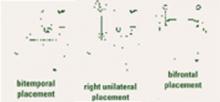Although numerous psychotropic agents in multiple classes have emerged over the past few decades, electroconvulsive therapy (ECT) still represents an essential treatment in modern psychiatry. Its record of safety and efficacy is virtually unparalleled vis a vis pharmacological agents.
Advances in anesthetic technique, electrode placement, and electrical stimulus dosing allow ECT to be administered safely to even the most medically ill patients without excessive effects on memory, with excellent clinical benefits (Box 1). A typical course of ECT consists of 8 to 10 treatments administered 2 to 3 times per week.
The medical complications of ECT are rare, and good pre-treatment medical assessment helps ensure its safety.1 Include at minimum a medical history, physical exam, and basic laboratory tests. Specialist consultations are sometimes necessary when patients have comorbid neurologic or cardiologic illnesses (Box 2).
The most bothersome side effect of ECT is memory disturbance. This takes 3 forms: post-treatment confusion and anterograde or retrograde amnesia (Box 3). Less serious side effects include headaches, muscle soreness, and nausea. These are easily treated symptomatically with analgesics or antiemetics.
Electroconvulsive therapy (ECT) has been in use since 1938.6 It consists of the application of an electric current to the head, which causes a seizure.
Modern ECT technique involves the use of general anesthesia, usually with a barbiturate anesthetic such as methohexital, and muscular paralysis, usually with the depolarizing neuromuscular blocking agent succinylcholine. Continuous oxygenation with positive pressure ventilation, measuring of blood pressure, and monitoring with an electrocardiogram and pulse oximetry make the procedure exceedingly safe.
Efficacy and cognitive side effects may be affected by how ECT is administered. The two treatment electrodes that are placed on the head can be located on either side of the temporal fossa (the bitemporal position), on either side of the forehead (the bifrontal position), or on the right temporal fossa and just to the right of the vertex of the skull (the d’Elia unilateral position). Generally, unilateral electrode placement causes less memory impairment but has been believed to be less effective than bilateral electrode positions.6
Another technical factor receiving attention from researchers is the amount of electricity, or electrical dose, used to elicit the seizure. Generally, especially for unilateral ECT, high electrical doses are needed to attain acceptable treatment efficacy. In fact, one study indicates that if 6 times the minimum electrical seizure threshold is used for unilateral ECT, efficacy for depression is equal to that of bilateral ECT with less memory disturbance.23
Finally, treatment frequency affects ECT outcome: twice-weekly treatment schedules are associated with less memory disturbance—and only slightly slower clinical response—than thrice-weekly schedules.24
The most common indication for ECT is major depression. Using modern diagnostic criteria, most depressed patients respond to ECT. Some features that presage a particularly robust response include psychomotor retardation, psychosis, catatonia, and advanced age. Patients who have medication-resistant depression may require particularly potent forms of treatment, such as bilateral electrode placement and/or higher than usual electrical doses.
Patients with mania respond particularly well to ECT but, because of excellent responses with modern pharmacological agents, rarely need it. For patients with mania who are agitated and noncompliant, ECT may represent a life-saving option for stabilizing an acute episode. Finally, ECT may help yield stability for an acute exacerbation of schizophrenia or may extend the benefits of antipsychotic medication for those with chronic schizophrenia, in which case continuation of ECT is usually advisable.
When ECT is indicated for depression
Typical depressed patients receiving ECT have experienced functional decline and have resisted, or have not tolerated, antidepressant medication. Several specific factors affect whether ECT will help particular depressed patients:
Melancholic features From the earliest use of ECT, it seemed apparent that patients with melancholic depression respond better to ECT than do patients with atypical or mood-reactive depression. Early research seems to have borne this out. Roberts2 found that melancholic features such as psychomotor retardation and guilty ideations strongly and favorably predicted ECT response. More recent research, however, generally fails to find predictive value in ECT response in patients based on presence of melancholia.3
The medical and neurologic illnesses that place prospective ECT patients at higher than usual risk of complications include a brain tumor or other intracranial space-occupying lesion, increased intracranial pressure, unstable cardiac function, or high anesthetic risk.25
Patients with severe cardiac disease, such as congestive heart failure, coronary artery disease, or cardiac dysrhythmia, can almost always be treated with ECT safely with adequate attention to pretreatment medical stabilization and use of antihypertensive medications during the treatment to blunt the increase in myocardial oxygen demand during the seizures.


